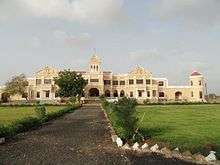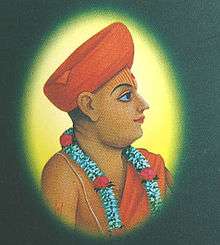Muli, Gujarat
| Muli મુળી | |
|---|---|
| village[1] | |
 Muli Location in Gujarat, India  Muli Muli (India) | |
| Coordinates: 22°38′20″N 71°27′29″E / 22.638808°N 71.458039°ECoordinates: 22°38′20″N 71°27′29″E / 22.638808°N 71.458039°E | |
| Country |
|
| State | Gujarat |
| District | Surendranagar |
| Population | |
| • Total | Over 9,000[2] |
| Languages | |
| • Official | Gujarati, Hindi |
| Time zone | UTC+5:30 (IST) |
| Telephone code | 02756 |
| Vehicle registration | GJ 13 |
| Climate | Dry (Köppen) |
| Website |
gujaratindia |
Muli is a town located 21 km (13 miles) southwest of the district capital of Surendranagar, Gujarat, India, by the Bhogavo River. [3] It has a population of greater than 20,000 people[4]
History
The name "Muli" may refer to either the city or the Indian Princely state of the same name. The Princely State of Muli had an area of 133 square miles (340 km2) and contained nineteen villages in addition to Muli city. The Parmars came to this area from Tharparkar District, now in Pakistan. The Parmars Lakh Dirji named it after a milkmaid who used to deliver milk to Lakh Dirji. The town is famous for the battle fought between the Chabhad and the Parmars for a wounded partridge.[5] Chabhhads wanted possession of the partridge, while the Parmars wanted to provide shelter to the wounded partridge. Later there was a big battle between Parmars and Chabhads, this war having historical importance because 140 Parmars got victory against 500 Chabhads of Sayla. The Parmars, while victorious, were sacked by an army from Sindh Province for providing shelter to some outcasts.
There is a temple of Almighty Sun called "Mandavrayji Mandir," which is also the spiritual center and "Kuldev" of Parmar Rajputs. It is said that one of the Parmar, King Sachoji, was a big donor and worshiper of Mandavrayji. He has a rule of giving anything which is asked of him. Once he was alleged to have been asked to give a lion alive, with the help of Mandavrayji, he was able to fulfill this promise. Till today, this fact remained as popular folklore in Muli village.
Educational institutes
- Matushri Dahiben Rajpal Girls High School
- Anopchand Rajpal Boys High School
- TejendraPrashad Boys High School
- Snaskar Sarita Private School
- Saraswati Vidha Mandir Private School
- Intkhab Alam boys high school
Places of interest
Places of interest include:

- Shree Swaminarayan Mandir, Limlipa
- Ambika-Nivas-Palace
- Sadawadi
- Bhayajibapa temple, Shligram ashram, Prasadi ni Waw, Limlipa
- Shaligram Haveli - Hindu god Shri Krishna is reputed to have stayed here for six months
- MandavRayji Mandir (Temple of the Sun) is the spiritual centre of the Parmar Rajputs.
- DarbarGadh (Himmat Bhuvan), At Darbar paa
- Raj Mahel (Ambika Palace), owned by the current Muli State Shri Thakor saheb Jitendrasinhji Parmar.
- Muli Royal Palace
- Muli Shakti Mandir
Swaminarayan Temple
There is a famous temple and a place of worship to Swaminarayan which is famous by the name of Shree Swaminarayan Mandir Muli.

The Shree Swaminarayan Mandir founder is a Shree Brahamanand swami.[6]
Temples
There are best carving Haveli, Shree Harikrishna Maharaj, Radhakrushna dev and Dharma dev-bhakti mata in the main temple, and Sabhamandap, Shree Ghanshyam Maharaj, free guest house, etc.
References
- ↑ http://www.census2011.co.in/data/village/512279-muli-gujarat.html
- ↑ http://www.census2011.co.in/data/village/512279-muli-gujarat.html
- ↑ https://surendranagardp.gujarat.gov.in/surendranagar/english/jillavishe/dhrangadhra.htm
- ↑ "Free weather data for Muli, Gujarat (India)". YR. Retrieved 11 September 2017.
- ↑ Pages 553 to 556 of the Gazetteer of the Bombay Presidency, Volume VIII, Kathiawar. Government Central Press, Bombay, 1884, have a thorough history of Muli. This book is available as a free download from Google Books.
- ↑ mulimandir.com
External links
- www.ssgd.org
- Saurashra ni Rasdhar" by Zawerchand Meghani (in Gujarati)